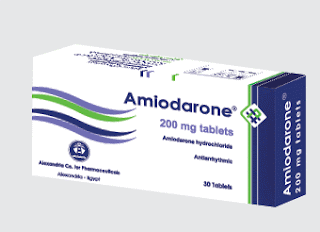 | ||
| Amiodarone 200 mg |
Amiodarone 200 mg
Amiodarone HCl 200 mg/tab.Company Name
Alexandria
Pharmaceutical form
Tablet
Package
30 or 1000 Tablets
Indications
Amiodarone is indicated only for the treatment of the following documented, life-threatening recurrent ventricular arrhythmias when these have not responded to documented adequate doses of other available antiarrhythmics or when alternative agents could not be tolerated. 1. Recurrent ventricular fibrillation. 2. Recurrent hemodynamically unstable ventricular tachycardia. As is the case for other antiarrhythmic agents, there is no evidence from controlled trials that the Use of Amiodarone favorably affects survival
Warning & Precautions
Pulmonary Toxicity: Amiodarone may cause a clinical syndrome of cough and progressive dyspnea accompanied by functional, radiographic, gallium –scan, and pathological data consistent with pulmonary toxicity, when Amiodarone therapy is initiated, a baseline chest X ray and pulmonary-function tests, including diffusion capacity, should be performed. The patient should return for a history, physical exam, and chest X ray every 3 to 6 months Hypersensitivity pneumonitis: usually appears earlier in the course of therapy, and rechallenging these patients with Amiodarone results in a more rapid recurrence of greater severity. Bronchoalveolar lavage is the procedure of choice to confirm this diagnosis, which can be made when a T suppressor/cytotoxic (CD8 – positive) lymphocytosis is noted. Steroid therapy should be instituted and Amiodarone therapy discontinued in these patients Liver Injury: Elevations of hepatic enzyme levels are seen frequently in patients exposed to Amiodarone and in most cases are asymptomatic. If the increase exceeds three times normal, or doubles in a patient with an elevated baseline, discontinuation of Amiodarone or dosage reduction should be considered. Loss of Vision: If symptoms of visual impairment appear, such as changes in visual acuity and decreases in peripheral vision, prompt ophthalmic examination is recommended. Appearance of optic neuropathy and/or neuritis calls for re-evaluation of Amiodarone therapy. Neonatal Hypo-or Hyperthyroidism: Amiodarone can cause fetal harm when administered to a pregnant woman. In general, Amiodarone should be used during pregnancy only if the potential benefit to the mother justifies the unknown risk to the fetus. Worsend arrhythmia: Amiodarone can cause serious exacerbation of the presenting arrhythmia which include new ventricular fibrillation, incessant ventricular tachycardia, increased resistance to cardioversion.
Product Type
Human
Dosage
As directed by the physician or as follows:
Amiodarone should be administered only by physicians who are experienced in the treatment of life- threatening arrhythmias
Individual patient titration is suggested
Because of the serious nature of the arrhythmia and the lack of predictable time course of effect, loading should be performed in a hospital setting. Loading doses of 800 to 1600 mg/day are required for 1 to 3 weeks (occasionally longer) until initial therapeutic response occurs.(Administration of Amiodarone in divided doses with meals is suggested for total daily doses of 1000 mg or higher, or when gastrointestinal intolerance occurs) If side effects become excessive, the dose should be reduced. Elimination of recurrence of ventricular fibrillation and tachycardia usually occurs within 1 to 3 weeks, along with reduction in complex and total ventricular ectopic beats.
Upon starting Amiodarone therapy, an attempt should be made to gradually discontinue prior antiarrhythmic drugs when adequate arrhythmia control is achieved, or if side effects become prominent, Amiodarone dose should be reduced to 600 to 800 mg/day for one month and then to the maintenance dose, usually 400 mg/day. Some patients may require larger maintenance doses, up to 600 mg/day, and some can be controlled on lower doses. Amiodarone may be administered as a single daily dose, or in patients with severe gastrointestinal intolerance, as a b.i.d. dose. In each patient, the chronic maintenance dose should be determined according to antiarrhythmic effect as assessed by symptoms, The lowest effective dose should be used to prevent the occurrence of side effects. In all instances, the physician must be guided by the severity of the individual patient’s arrhythmia and response to therapy. Dosage suggestions are summarized below.
Ventricular Arrhythmias :
Loading dose (daily): 1 to 3 weeks : 800 to 1600 mg.
Adjustment and Maintenance dose (Daily) : ~ 1 month : 600 to 800 mg, usual maintenance : 400 mg.
Adverse Reactions
Gastrointestinal: Nausea and vomiting, Constipation, anorexia. Dermatologic: Solar dermatitis/photosensitivity. Neurologic: Malaise and fatigue, tremor/abnormal involuntary movements, lack of coordination, abnormal gait/ataxia, dizziness, paresthesias. Ophthalmologic: Visual disturbances. Hepatic: Abnormal liver-function tests. Respiratory: Pulmonary inflammation or fibrosis.
Contra Indications
Severe sinus – node dysfunction, causing marked sinus bradycardia; second and third degree atrioventricular block; and when episodes of bradycardia have caused syncope (except when used in conjunction with a pacemaker) . Known hypersensitivity to the drug
Drug Interactions
Cyclosporine: Concomitant use of Amiodarone and cyclosporine resulting in elevated creatinine, despite reduction in dose of cyclosporine. Digitalis: On initiation of Amiodarone, the need for digitalis therapy should be reviewed and the dose reduced by approximately 50 % or discontinued. Anticoagulants: The dose of the anticoagulant should be reduced by one – third to one-half, and prothrombin times should be monitored closely. Antiarrhythmic Agents: In general, any added antiarrhythmic therapy drug should be initiated at a lower than usual dose with careful monitoring.
No comments:
Post a Comment